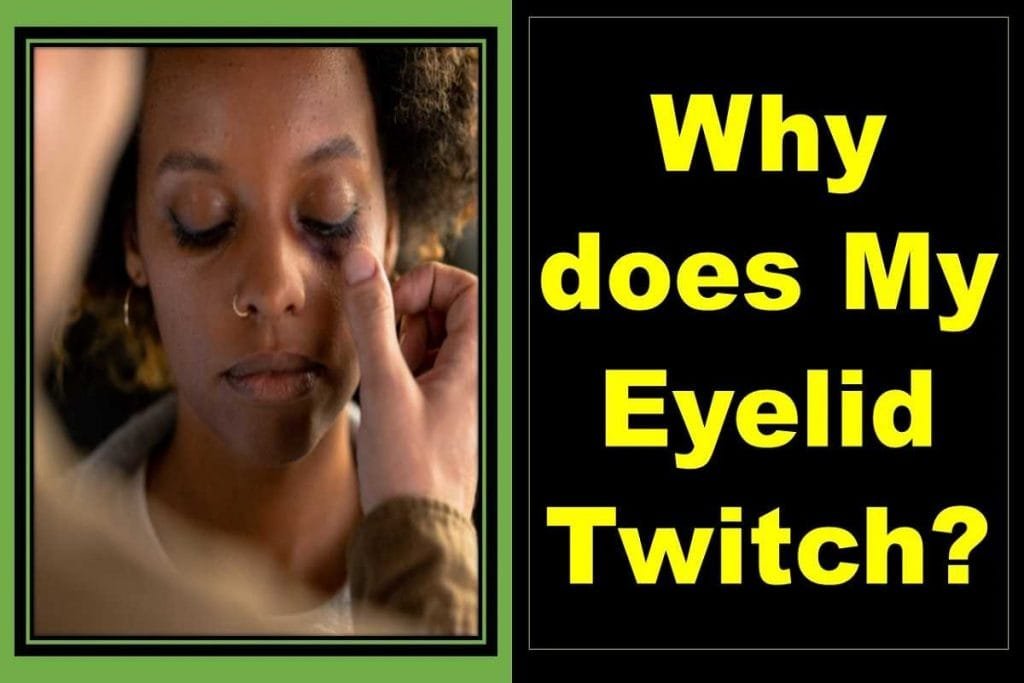Why does my eyelid keep twitching? What causes eyelid twitching? Is there any treatment to stop twitching eyelids? Keep on reading to find out answers to these questions related to eyelid spasms.
An eyelid twitch is a general term for the muscle spasms that happen, usually without the control of the person. Either upper or lower eyelid may close halfway and reopen multiple times in a short period of time.
Eyelid twitching is a reflex of the eyelid muscle. The exact cause of the eyelid twitch is still unknown but can be triggered by stress, fatigue, or caffeine.
To know in detail about twitching eyelids, we first need to understand eyelid spasms and their types.
Eyelid Spasm
Eyelid spasms refer to involuntary, rapid movements of one or both of the eyelids. They are not within your control.
A little bit of eyelid twitching may be considered normal and does not present any serious problem. Minor eyelid spasms can be caused by a variety of factors and usually go away with time.
If these twitches keep happening and are interfering with your everyday activities, you might want to see a doctor about them.

Types of Eyelid Spasm
Eyelid spasms are classified as eyelid twitches or tics, essential blepharospasm, and hemifacial spasms.
Essential Blepharospasm
Essential blepharospasm is a muscle disorder where one or both of your eyelids shut involuntarily. This can happen over the course of hours and may cause you to blink, wink, or pinch up your face. Advanced stages will make it difficult for you to see as eyelids are shut so tightly.
Essential blepharospasm may also affect other muscles in your face. This means you may have trouble with tasks where you have to use lots of different muscles of the face such as climbing stairs, driving a car, going to work, or doing anything else.
Doctors do not know the exact cause of blepharospasm, but they are reasonably sure that it originates with a nerve impulse. In some cases, the cause may be hereditary, or the result of an injury to the cranial nerve.
If your eyelid spasms last for a long time and don’t go away, you might have benign essential blepharospasm. This typically affects both eyes more often in women than in men.
The condition affects up to 20,000 to 50,000 people in the United States alone and usually develops in middle or late adulthood. It will likely worsen with time. Symptoms may be cloudy vision, facial spasms, and increased photophobia (increased sensitivity to light).
Hemifacial Spasms
A hemifacial spasm is when one half of your face gets spasms. These may start by contracting around the eye and then moving to other facial muscles. There are different levels of severity that can affect people for short or long periods of time
In hemifacial spasms, a blood vessel presses on a facial nerve. This causes one side of the face to twitch uncontrollably. Most people with hemifacial spasm develop it in their 20s or 30s and incidences increases with increasing ages. Still, there’s no known cause of the hemifacial spasm.
This disorder is much more of a problem for women than it is for men. Asians are also more likely to have it.
If left untreated hemifacial spasms can lead to some pretty debilitating symptoms including uncontrollable eye twitching, an inability to open your eyes, twitching in the muscles of one side of your face.
Eyelid Twitching
Eyelid twitching is an involuntary spasm of the eyelid that can be caused by stress, caffeine, lack of sleep, or a variety of other factors. It is not considered to be a serious disorder and most people only experience it occasionally.
The occasional twitch of your lower or upper eyelid (also known as myokymia) is usually nothing to worry about. It typically resolves within a few days and can be attributed to sleep deprivation, stress, or too much caffeine.
Though eyelid twitching can often be a sign of other serious health issues, it is unlikely to be the cause for most people.
Most people experience these twitches only as a mild tug on the eyelid but some may also experience them as more intense and forceful enough to fully close the eyes for a short period of time. This can happen regularly over a few minutes until it subsides.
It’s hard to predict when the twitch will occur, as it might go for up for days. The twitch could then be gone for weeks or even months.
Eyelid twitches are usually painless and harmless but can be bothersome. In most cases, the spasm will resolve before you need to seek treatment.
In some cases, eyelid spasms can be a symptom of a chronic movement disorder. For example, if the spasm is coupled with facial twitches or uncontrolled movements.
Recommended Article: Right & Left Eye Twitching Superstition, Spiritual Meaning, and Omen
Symptoms of Eyelid Twitching
Common symptoms of eyelid twitching include:
- Involuntary, repeated uncontrollable twitching or spasms of the upper or lower eyelids (most commonly the upper lid)
- Increased sensitivity to light and watery eyes.
- Increased rate of eye blinking
- Blurred vision (occasionally)
There are a variety of symptoms for eyelid twitching or spasms and the ones listed above may or may not be a sign. That being said, if you experience one or more of the symptoms, please contact your eye specialist for an eye exam.
What Causes Eyelid Twitching?
Apart from hemifacial spasm and essential blepharospasm, there are many other factors that can cause it. Some of these conditions may include:
- Lack of sleep or rest
- Too much stress or physical exertion
- Too much caffeine, alcohol or tobacco, or other beverages with caffeine
- Eye strain or eye irritation caused by contact lens or other particles inside the eyes
- Dry eyes due to excessive screen work or other related factors
- Inflammation of the different parts of the eye such as uveitis, blepharitis, or conjunctivitis
- Working in excessive bright light for long hours
- Rarely, eyelid twitching can be a side effect of a medicine used for migraine headaches
- Multiple sclerosis also causes eye twitching. Along with eye twitch, nystagmus, internuclear ophthalmoplegia, optic neuritis, and double vision might occur.
- Few people with essential blepharospasm suffer from another additional neurological condition
- The exact cause of hemifacial spasm is unknown, but it is believed to be caused by an abnormality in the nerve that leads to the facial muscles. Facial twitching may accompany hemifacial spasm as well
Rare Complications of Twitching Eyelids
Rare cases of eyelid spasms can be a sign of a more serious condition such as brain or nerve disorder. When related to these conditions, eyelid twitches are usually accompanied by other symptoms
Brain and nerve conditions that have been shown to cause eyelid twitching include dystonia, Bell’s palsy, cervical dystonia multiple sclerosis, Tourette syndrome, and Parkinson’s disease.
Home Remedies or Treatment for Twitching Eyelid
Eyelid twitching often resolves without any medical treatment. In the meantime, the following steps may help reduce or eliminate your symptoms.
- Get adequate sleep
- Reduce intake of caffeine beverages
- Consume less alcohol
- Lubricate your eyes with over-the-counter refreshing eye drops
- apply hot compression to the eyelids of affected eye
Botulinum toxin injections are useful for reducing eyelid spasms, but if the condition worsens or does not respond to treatment, a surgical procedure may be required in more extreme cases.
Treatment for Hemifacial Spasm
A hemifacial spasm is characterized by intermittent tightening of the muscles around one side of the face. The first step in treating a hemifacial spasm includes stretching exercises and massage therapy.
Many people have found relief from hemifacial spasms with botulinum toxin injections. Similar to treatment for blepharospasm, Botox injections relax the affected nerve in hemifacial spasms.
Although treatments like drug therapy might be used, injections are usually more effective. Rarely though, some people need surgery to release pressure from a nerve that’s being compressed.
The doctor will discuss with you the different types of treatments available for your condition.
Treatment Options for Blepharospasm
There are various treatments for blepharospasm, but botulinum toxin shots are the most effective of them. A needle is inserted in the muscles above and below the eye to inject a muscle-relaxing substance. They work great and last a while!
Spasms usually disappear after the injection at 1-2 weeks and can last up to 3 months.
Unfortunately, sometimes injections don’t work or are not recommended. In this case, your doctor might prescribe certain medications to try and manage the condition. Occasionally, it comes down to balancing how much benefit there is with the risk of side effects.
Surgery is a treatment option when injection-and medicine-directed treatments for your spasms fail. There are two common types of surgery for essential blepharospasm- one type of surgery removes the facial muscle that causes spasms and another removes a portion of the nerve which makes spasms less likely to occur.
Your ophthalmologist will talk to you about the treatment options for your case of blepharospasm.
When to See an Eye Doctor for Eyelid Twitching?
It’s very rare for eyelid twitches to be serious enough to need an emergency visit. But if you see your eyelids spasm chronically, it could be a symptom of something serious like a brain or nervous system disorder.
If you are experiencing chronic eyelid spasms and any of the following symptoms, then you might want to contact your doctor about it.
- Eyelid twitching may take a while to subside. Vitis your doctor if it does not go away within a week
- Eyelid twitch completely covers your eyes (one or both) with eyelids.
- You notice twitching in other parts of the face along with eyelid twitching
- Redness, swelling, or a discharge from your eye
- Droopy upper eyelid
Takeaway
Eyelid twitches are a common condition where muscles around the eye start to contract. The exact cause is not known. There are many possible treatments, including eye drops, muscle relaxants, and Botox injections. Treatment will depend on the severity of the condition and on how troublesome it is for the patient.
One of the more interesting questions invested in by researchers is whether there’s a genetic link to eyelid twitches. The answer still isn’t clear, but at least they have some evidence that it doesn’t run in families.
Studies have shown that eyelid twitchy movements caused by lifestyle factors typically have the best outlook. An underlying health condition is sometimes responsible and treating this condition may help relieve the twitching.

